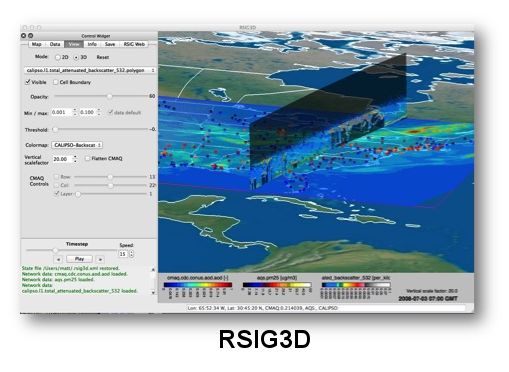Remote Sensing Information Gateway
RSIG Team Optimizing for New TEMPO L3 Data Format
The new V03 TEMPO L3 files are gridded at a higher resolution than previous versions. This can lead to timeouts when trying to retrieve this data over CONUS in RSIG3D. The RSIG Team is working to implement a more efficient scheme for processing/representing this data and will soon have a more workable solution.
New Interface: pyrsig
As an alternative to RSIG3D, pyrsig is a Python interface that leverages RSIG’s web services to import data directly into pandas dataframes and xarray datasets. This makes it easy to do advanced analysis and visualization in a “Pythonic” way. The pyrsig user’s guide has all the information that you need to get started.
RSIG Infrastructure Updates
RSIG back-end infrastructure components were recently updated. If you are experiencing any difficulty accessing data, please report it to RSIG Technical Support. To help us diagnose any potential issues, please include:
- The date and time that you experienced the difficulty.
- The data source and variable that you tried to access.
- The date for the data that you were requesting.
About RSIG
The Remote Sensing Information Gateway (RSIG) allows for quick and easy access to subsets of multi-terabyte environmental datasets pertaining to air quality, including satellite, modeled, and in-situ sensor data. The old process of downloading and parsing data (taking days, weeks, or months) is reduced to minutes with RSIG.
- RSIG3D -- under active development -- is a standalone application for Windows and Mac OS X systems with a richly immersive and interactive visualization capability. It offers 2D and 3D visualization and saving of data from rsigserver. RSIG3D receives data (often 3D, up to one week) rather than images of the data, therefore the user's computer requires about 8GB of memory (enough for up to 5 global datasets).
- rsigserver is a web service that conforms to the Open Geospatial Consortium (OGC)-Web Coverage Services (WCS)/Web Mapping Services (WMS) standards. rsigserver streams subsets of atmospheric data to applications. Applications currently using rsigserver include: RSIG3D, pyrsig, Air Sensor Network Analysis Tool (ASNAT), Estuary Data Mapper, Real-TIme GeOspatial Data Viewer (RETIGO), custom scripts, custom external applications, etc. Users can also construct web server scripts to access RSIG data via rsigserver.

About RSIG
RSIG can tap into a wide range of key environmental models and data, such as NASA's Moderate Resolution Imaging Spectroradiometer (MODIS), the Environmental Protection Agency's (EPA) Community Multi-scale Air Quality (CMAQ) model output, National Environmental Satellite, Data, and Information Service (NESDIS) biomass burning data, and ground station measurements from AIRNow and EPA's Air Quality System (AQS). RSIG also enables users to integrate their selected datasets into a unified visualization.
The benefit to users and consumers of environmental data is fast acquisition of only the data they want to see and in a standard format they can save to their desktop PC.
RSIG's Key Features
- One access point to many data sources. The RSIG provides a single Web site that serves as a selective access point to many kinds of data.
- Streams only the needed data. The RSIG accesses large numbers of files from diverse sources and streams the user-selected subset of data back to the user's desktop. Streaming works in the same way as streaming audio works on the Web: the data goes directly to the client computer's memory and is discarded unless the user saves it to a file.
- Aggregates separate data files into a single stream. RSIG aggregates the multiple files of a given data type into a single stream, reducing the download burden and simplifying data analysis.
- Built-in visualization. RSIG can immediately integrate multiple selected datasets into a single MPEG animation. For example, EPA AIRNow data can be layered over NASA's MODIS satellite data, or a user can compare CMAQ predicted outputs and actual ground sensor data. The user can also save the animation or individual images to their computer.
- Saves data to standard formats. RSIG integrates incoming proprietary dataset formats into standard formats the user can save on their computer. A user can save the data or visualization--or both--to their local computer in such standard formats as portable binary, ASCII, NetCDF IOAPI and COARDS, GeoTIFF, MPEG and KMZ. The user can then export the selected datasets from RSIG into other applications--such as GIS tools--for further analysis
- Fast. RSIG accomplishes all of this far faster than a lone user could with currently available means. For example, RSIG can capture a week of MODIS AOD data in a few minutes, compared to two months using conventional web-form ordering/ftp approaches.
RSIG's Architecture
This poster describes in detail RSIG's flexible and extensible architecture. The architecture enables RSIG to serve many types of data with an emphasis on convenience, high-performance, data integrity, and security. Depending on the speed of your connection, the poster may take a few seconds to load for viewing.

